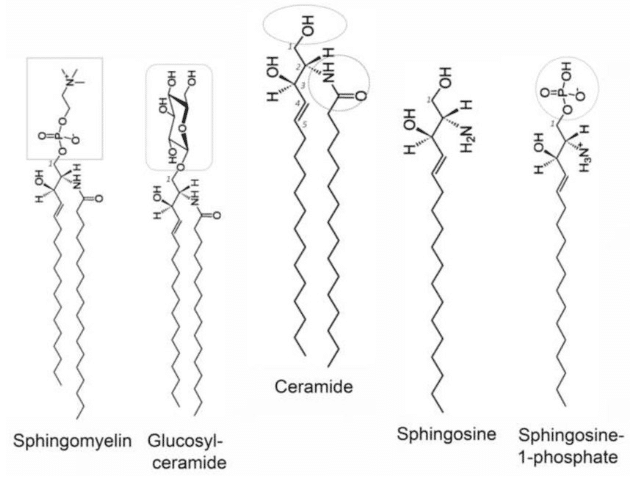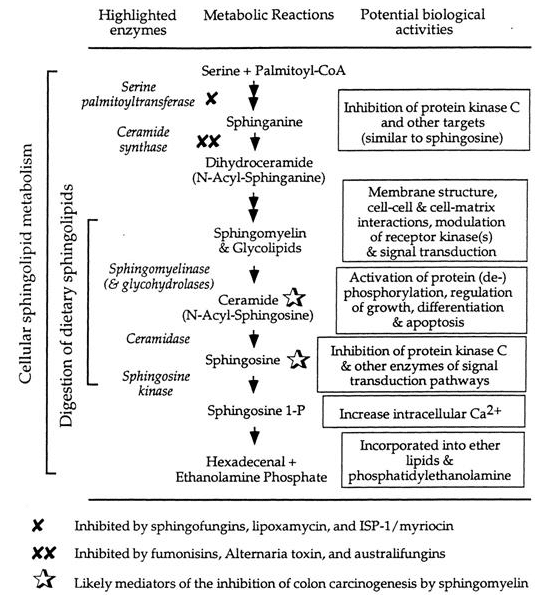What Are Sphingolipids?
Sphingolipids are a class of lipids that are important biological molecules and have a backbone comprising sphingoid bases, which include sphingosine (aliphatic amino alcohol) or other compounds that are structurally similar. After their discovery in the 1870s, sphingolipids are derived from the name of the Sphinx. In biological organisms, sphingolipids play crucial roles in structure and signaling. They also play important roles in apoptosis and cell proliferation. Sphingolipids can be found in plants, animals, and a few bacterial strains.

Types of Sphingolipids
Several types of sphingolipids are characterized by different chemical and structural elements, which are attached to the sphingoid backbone. Ceramides are the simplest class of sphingolipids and consist of sphingosine and fatty acid; all other sphingolipids are derived from them. Glycolipids form a large group of sphingolipids, which contain one or more molecules of sugar such as galactose or glucose. Glycolipids comprise several subclasses, including cerebrosides, ceramide oligosaccharides, and gangliosides. Cerebrosides are highly abundant in the myelin sheath and are limitedly distributed in nature. Sulfate-containing cerebrosides are called sulfatides. Gangliosides contain several carbohydrate molecules, which include N-acetylneuramine, N-acetylglucosamine, and sugar components. In addition, ceramide oligosaccharides comprise several molecules of carbohydrates. Globoside is an example of this sphingolipid class and is present in red blood cells. Sphingomyelins, found in both the blood and nervous tissues, are the only phosphorous-containing sphingolipids. They play an important role in many signaling pathways, and the metabolism of these biological molecules produces many significant products for cell function. Sphingolipids are primarily found in nerve cell membranes and are distributed throughout the body. In the myelin sheath, they constitute approximately 25% of the lipids. They were first identified in the brain tissue. Some subclasses of sphingolipids are found in other parts of the body such as the blood and spleen.

Sphingolipid Biosynthesis
For the eukaryotic plasma membrane, sphingolipids constitute indispensable building blocks. They also participate in wide-ranging biological processes within the cell. At any step in these processes, disruption of sphingolipid biosynthesis leads to growth arrest of mammalian and fungal cells. On the contrary, an excess of sphingolipid precursors or sphingolipids is also toxic. Therefore, sphingolipid biosynthesis is strictly regulated. In this regulation, the involvement of plasma membrane microdomains in fungi, especially of the eisosome, has been documented.
Functions of Sphingolipids
Sphingolipids exhibit multiple biological functions and are found in abundance in the central nervous system. They participate in cell recognition and adhesion, tissue development and act as receptors for toxins. During myelination, a wide range of interactive molecules such as myelin-associated glycoprotein, myelin basic protein, cholesterol, phospholipids, sphingolipids, etc., have a complex role. However, the precise roles of some sphingolipids are yet to be explored. Depending on the sphingolipids, bacteria develop and survive within the host cell, in addition to attachment and uptake of pathogenic bacteria. Sphingolipids are known to play an important role in human diseases, in diverse conditions such as infection and inflammation, neurological and immunological diseases, psychiatric disorders, and cancer. Thus, sphingolipids are termed fundamental players that regulate human health and disease. Sphingolipids include sphingosine (Sph)/dihydrosphingosine (dhSph), ceramide (Cer)/dihydroceramide (dhCer), and glucosyl/galactosylceramide (glc/galCer). During the development of the rat brain, Cer/dhCer level rises to start from the embryonic stage to postnatal day, then gradually decreases until maturity, and remains steady throughout the brain development. GlcCer is the initial mono glucosylceramide, which appears at the early postnatal stage. The profiles of all these sphingolipids indicate their importance during the development of the rat brain. Cer is involved in neurodegenerative diseases such as Parkinson’s disease and Alzheimer’s disease. Sph is a potent inhibitor of protein kinase C and has recently been involved in the demyelination of the central nervous system due to multiple sclerosis. In conclusion, sphingolipids are important for brain development. However, they have damaging effects on diseases such as multiple sclerosis.

Disadvantages of Sphingolipids
- The increased risk of metabolic and cardiovascular diseases has been found in some genetic disorders, which are related to alterations in sphingolipid metabolism.
- In patients with hypertension, ceramide level is increased. Its concentration correlates with the severity of the disease.
- In patients with acute internal carotid artery occlusion, the neural ceramide level was increased, due to the high degradation of ganglioside-sphingolipids that are highly concentrated in the central nervous system.
- A significant increase in plasma ceramide levels was found in patients with diabetes mellitus.
- Significant increase in plasma levels in patients, immediately after percutaneous coronary intervention, mostly resulted from transient ischemia.






